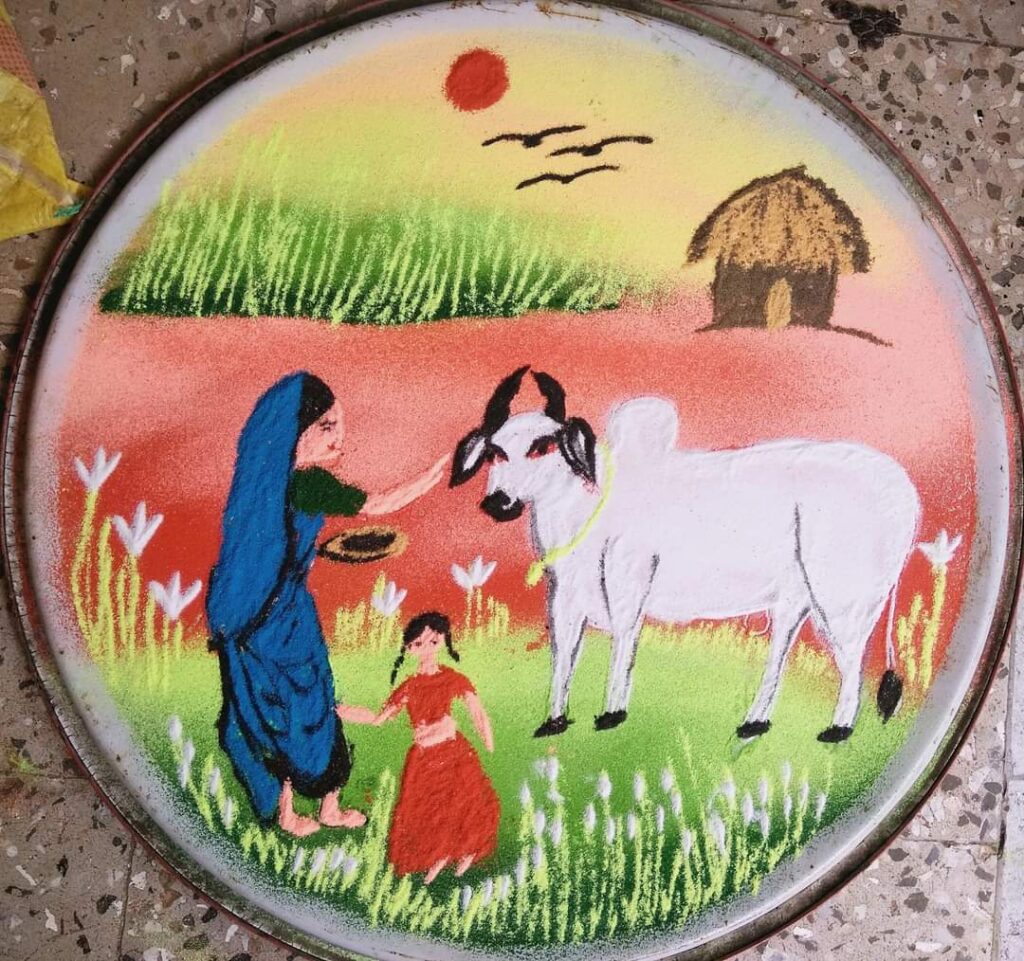Vasubaras: Celebrating with Rangoli Art

Hey there, young reader! Have you ever heard of Vasubaras? It’s a vibrant festival celebrated in Maharashtra, India, with great joy and enthusiasm. Vasubaras, also known as Govatsa Dwadashi, is a unique festival that honors and celebrates the significance of cows and their calves. It falls on the twelfth day of the Hindu month of Kartik (October-November). One of the most delightful aspects of Vasubaras is the creation of beautiful rangolis. Rangolis are intricate patterns made using colored powders or flowers, and they play a crucial role in many Indian festivals. In this article, we’ll explore the significance of Vasubaras, the art of creating Vasubaras rangolis, and the different types of rangolis seen during festivals.
Vasubaras holds a special place in the hearts of people in Maharashtra. This festival celebrates the deep bond between cows and humans, especially the love and care showered upon them by farmers. On this day, farmers express their gratitude to cows and seek blessings for their well-being and prosperity. It is believed that Lord Krishna, who is fondly known as Govinda, spent his childhood in a village surrounded by cows. Hence, the celebration of Vasubaras is also associated with Lord Krishna and his divine connection with cows.
Vasubaras Rangolis:
Now, let’s dive into the fascinating world of rangolis! Rangolis are traditional art forms that add vibrancy and beauty to various festivals and occasions. They are made using a variety of materials such as colored powders, rice flour, flowers, or even grains. Rangolis are not just decorative patterns; they hold cultural and religious significance.
During Vasubaras, rangolis are created to adorn the entrances of homes and cowsheds. These intricate designs not only enhance the visual appeal of the surroundings but are also believed to invite good luck and positive energy. They are a way of welcoming and honoring the divine presence during the festival.

Types of Rangolis.
Freehand Rangoli: This is the most basic form of rangoli, where artists draw patterns directly on the ground or floor using their hands. Freehand rangolis allow for creativity and spontaneity, making them popular among young enthusiasts.
Powder Rangoli: Colored powders, called gulal or rangoli powder, are used to create vibrant and eye-catching designs. The powders are carefully poured onto the ground and shaped into various intricate patterns. Artists often use stencils or templates to achieve symmetry and precision.
Flower Rangoli: As the name suggests, flower rangolis are made using a variety of fresh flowers. These rangolis emanate a fragrant aroma and are particularly popular during festivals like Vasubaras. Flowers like marigold, rose petals, and jasmine are used to create stunning designs, often incorporating intricate motifs and shapes.
Rice Flour Rangoli: Rice flour rangolis are commonly made during religious ceremonies and festivals. The fine white flour is used to create delicate and detailed patterns. Artists use their fingertips to carefully arrange the rice flour into intricate designs, which are believed to attract prosperity and wealth.
Vasubaras is a festival that brings joy and excitement to people’s lives. The tradition of creating rangolis during Vasubaras not only adds aesthetic appeal but also serves as a medium to express gratitude and devotion. Rangoli-making is an art form that allows individuals to showcase their creativity, imagination, and cultural heritage.
By participating in the creation of rangolis, young people like you can connect with the traditions and values associated with festivals like Vasubaras. You can explore your artistic skills, experiment with different colors, and design patterns that reflect your own unique style.
Remember, every rangoli you create is like a canvas where you can express yourself and share your happiness with others. So, embrace this beautiful art form and immerse yourself in the spirit of Vasubaras.
Next time you witness a rangoli during Vasubaras or any other festival, take a moment to appreciate the dedication and skill that goes into creating it. And if you feel inspired, grab some colored powders or flowers and give rangoli-making a try. Who knows, you might discover a hidden talent and add more colors to the world around you!
Happy Vasubaras and Happy Rangoli-making!

